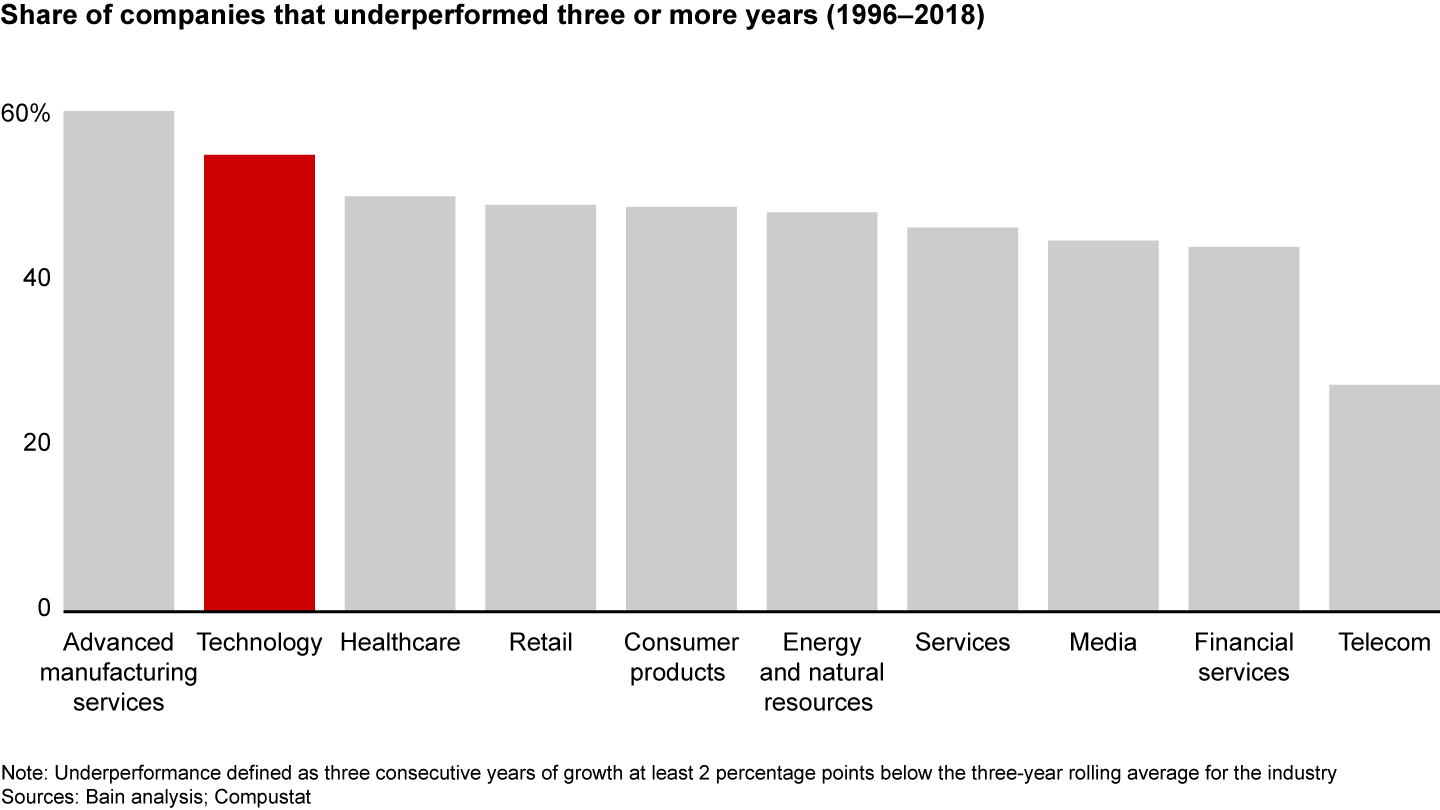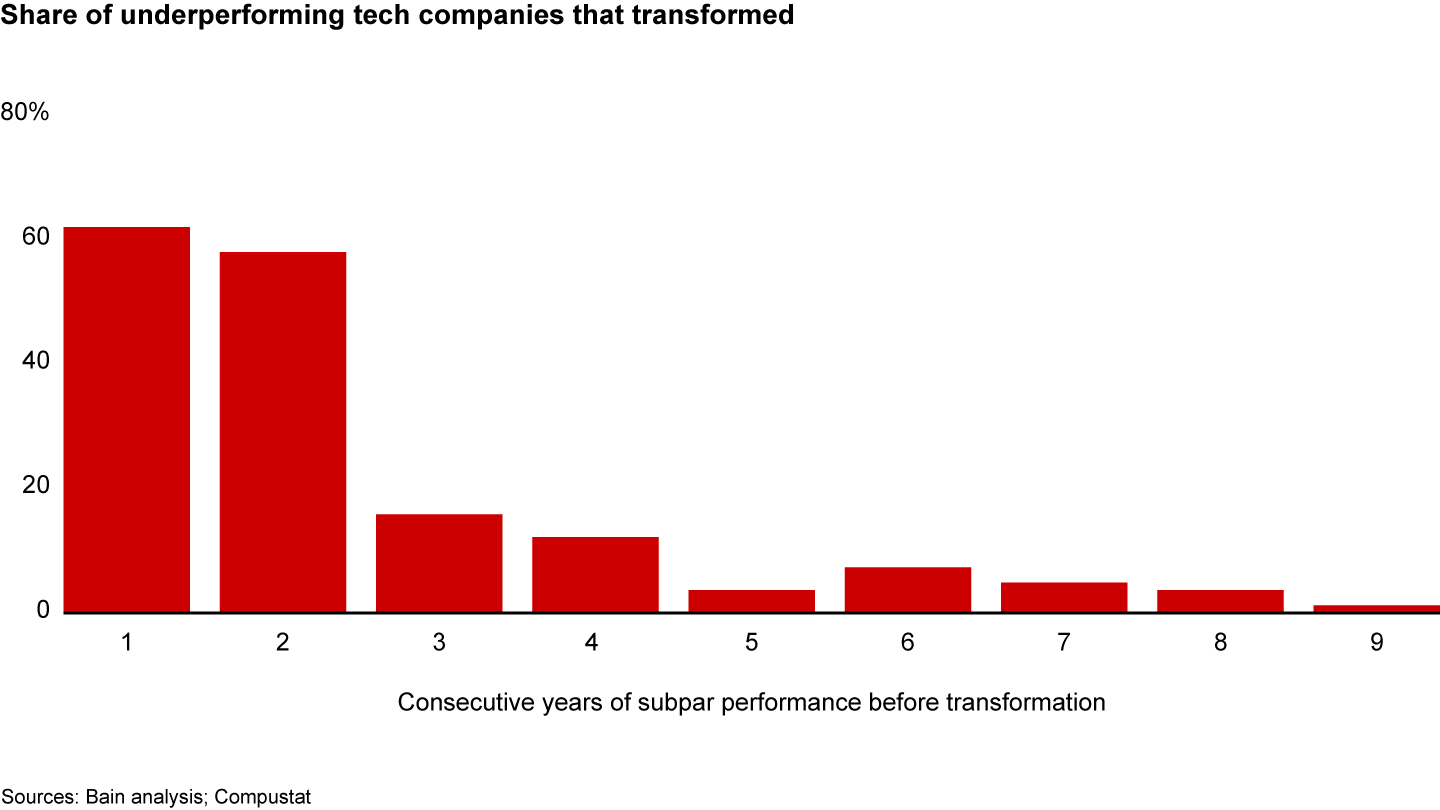Technology Report
 }
}
In evidenza
- More than 75% of the largest venture capital investments in recent years went to IT infrastructure and industry-focused enterprise software companies, illustrating the potential for innovation perceived in these sectors.
- Many incumbents overlook or underestimate the signals of impending disruption until it’s too late.
- The most successful reject the legacy mindset, effectively monitor emerging business threats, invest in a clear R&D and M&A strategy, and fearlessly disrupt themselves.
This article is part of Bain's 2022 Technology Report.
When 75% of the largest venture capital investments move assertively in one direction, it’s time to take notice.
That’s the situation in which the leaders of incumbent enterprise software companies find themselves. From 2017 to 2021, more than three-quarters of VC investments of $100 million or more went to IT infrastructure and industry-focused, or vertical, software companies, according to Bain & Company analysis of our Startup Investment Cruncher database (see Figure 1).
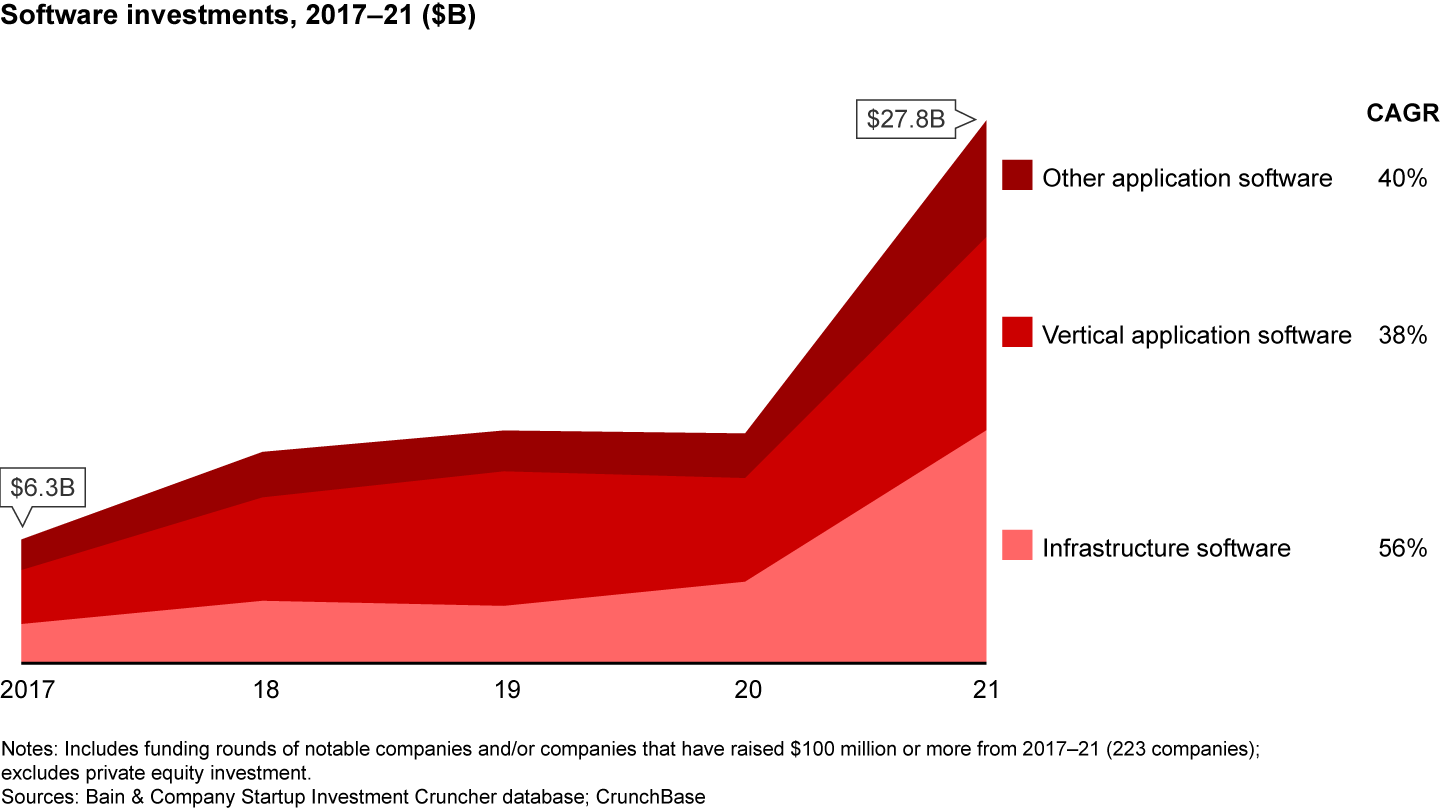
Investors are backing start-ups that are taking aim at software markets supposedly immune to disruption in industries as disparate as education, healthcare, restaurants, and auto dealerships. These markets historically had high barriers to entry and loyal customers, and the cost of switching to alternative vendors was high.
Now, however, companies can develop and deploy new software more quickly and easily than ever, thanks to open-source software architectures and platforms that make it possible to develop apps with little to no coding expertise. As a result, start-ups are no longer afraid of markets that long appeared untouchable and are gradually winning over customers.
Consider Toast, which in just over a decade has emerged as a leader in restaurant point of sale software with nearly $2 billion in annual revenue, thanks in part to a direct sales model and a simplified technology developed specifically for restaurants. Or look at legal management software provider Onit, which has used its cloud-based, “no-code” platform with a simple user interface to make products that are generally faster to implement and easier to use than legacy systems. That formula has made Onit one of the fastest-growing tech companies in North America.
Unfortunately for incumbents, many don’t pick up signals of impending disruption until it’s too late, or worse, they recognize the signals, but disregard them because they believe they’re in a niche, sufficiently sheltered market. In a 2022 Bain survey of executives at 98 tech companies, nearly 50% said they see disruptive threats to their company’s market share position as mild or not critical at all; only 5% saw such threats as severe. But other evidence suggests that tech companies are highly susceptible to the kind of disruption that leads to sector underperformance—and that the longer a tech company underperforms, the less likely it is to turn around (see Figure 2).
The incumbents that don’t heed signals of disruption continue to bet on the playbook that has worked for years: make a series of acquisitions, take out costs, manage the businesses for cash, and enjoy slow-but-steady growth. That playbook will likely remain valuable, but it’s no longer sufficient to protect against what’s coming. Although venture capital investment in and valuation of high-growth tech companies both declined in the first half of this year, such drops won’t curb the long-term increased pace of disruption.
Now is an opportune moment for incumbents to go on offense. In recent years, established companies were expected to deliver steady profits, and therefore had less freedom to invest in innovation, leaving them at a disadvantage against start-up competitors. But the rules are changing. Start-ups are under more pressure to deliver profits, not just growth. Incumbents have an opening to press forward and seize momentum.
Staying ahead of the game
Leadership that rejects the legacy mindset is the most important hallmark of software incumbents that have successfully defended against disruption. Not satisfied with slow-but-steady growth, these leaders want to be at the forefront of technology for their industry, and they take pride in what their products help their customers accomplish. This sounds like a given for any leadership team, but in truth many companies lose sight of these goals or only pay them lip service. That leaves their companies vulnerable to complacency and, eventually, irrelevance.
The most successful software incumbents put that mindset into action by focusing on three things.
Continually assessing potential threats and new business opportunities. Leading companies put defending against disruption at the heart of their strategy. There are a lot of ways to do this, but it's good to start by building competitive threat assessments into the annual planning process. Many tech companies have room to improve in this area. In a 2022 Bain survey of CIOs and CTOs, nearly half said their company doesn’t have a strong ability to identify potential disrupters in their core market (see Figure 3).
Figure 2: Figure 3
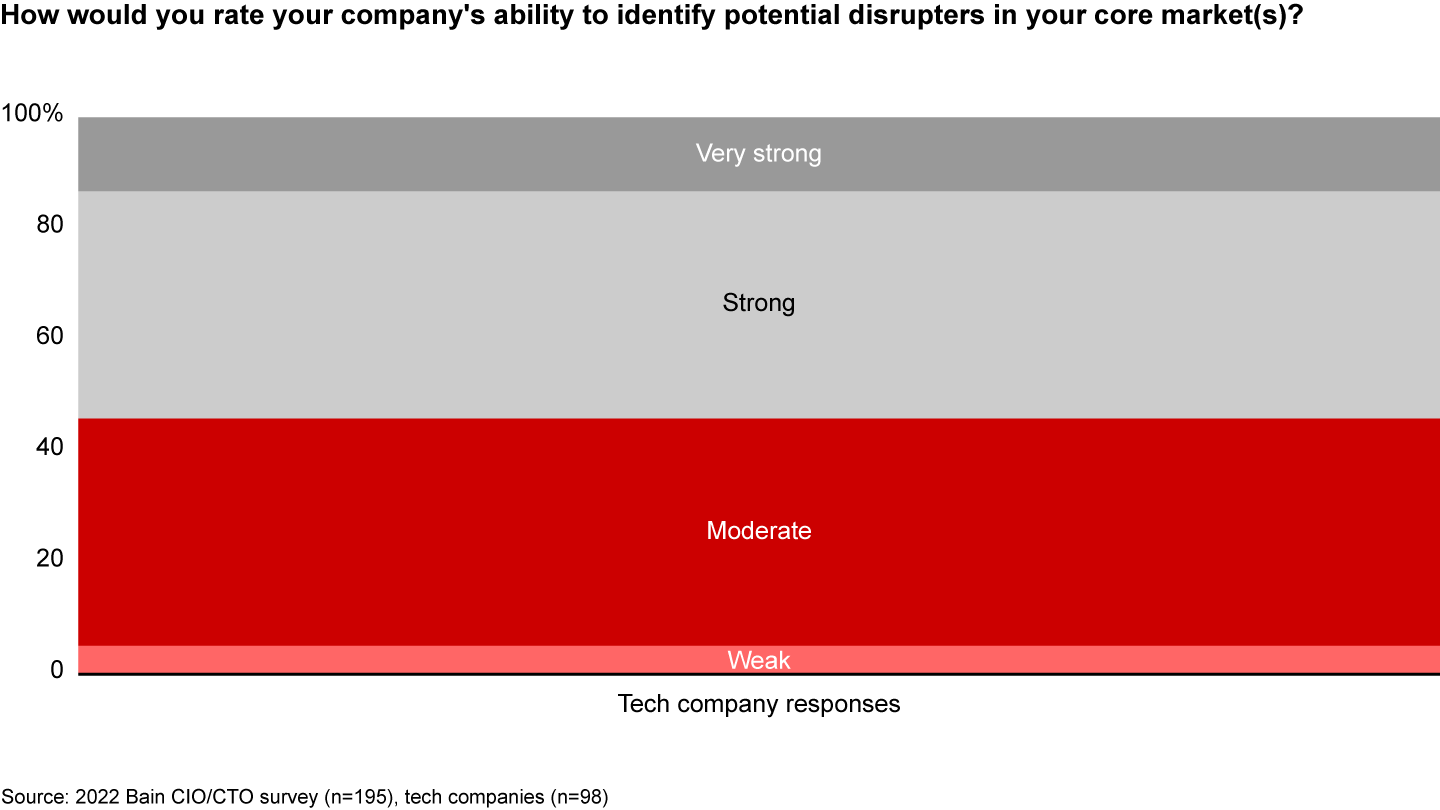
To avoid threat assessments becoming a check-the-box exercise, leading companies not only monitor the competitive landscape, but also think deeply about anything and everything that could emerge in the future to prey upon their business vulnerabilities. Paranoia is a virtue here.
Moving the CEO closer to the company’s R&D roadmap of products and tech capabilities. Sometimes, the response to disruption might simply require refreshing product features or adding new ones. But when it calls for a fundamental redefinition of the company’s core business, that’s a decision only the CEO can make—and it needs to be made quickly to stay ahead of the competition. Closer collaboration between the CEO and the head of research and development can also help incumbent software companies make the appropriate investment trade-offs in order to fix their “technology debt,” a common pitfall wherein companies choose incremental feature upgrades or additions at the expense of refreshing their core product, which can atrophy as a result.
Investing in migrating customers to the new offering. Once the company is ready to scale up a new, innovative product or modernized technology platform, managing the transition in the market can be even more difficult than navigating the internal shift. Customers might be reluctant or refuse to switch, which might spook the sales team or discourage it from promoting the new offering. And the board might not want to risk upsetting the status quo, which has worked for so long.
Leading companies reorient the sales team’s priorities to focus on the new offering, adjusting the team’s incentives if necessary. They build targeted sales plays around the new offering and ensure close communication between sales and R&D to make the customer migration work.
The most successful companies start small by winning “lighthouse” customers, a targeted set of existing buyers willing to try out nascent products. Then they use those success stories to persuade more customers to switch. Genesys’s cloud strategy illustrates how incumbents can turn potential disruption to their advantage (see Figure 4).
Figure 2: Figure 4
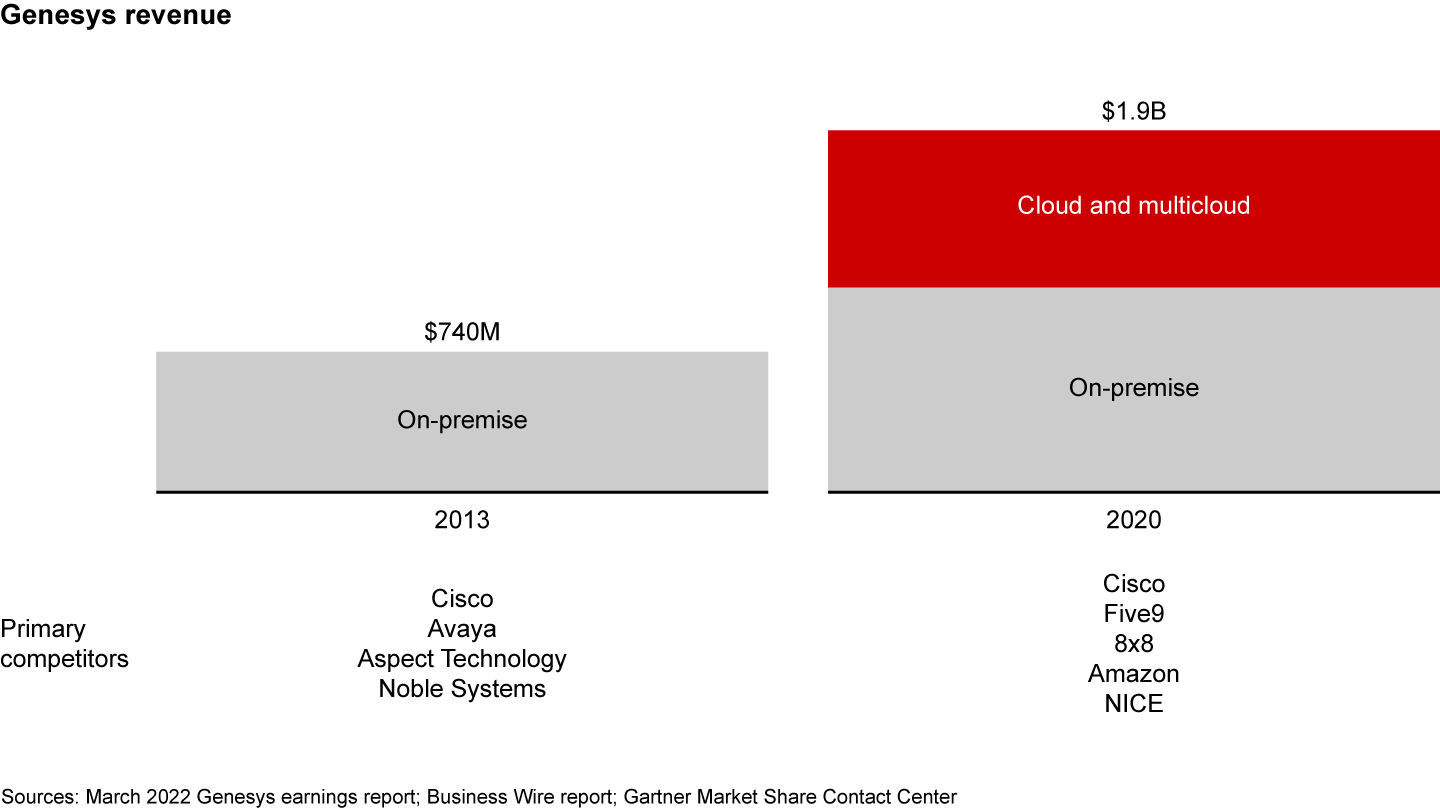
In 2013, a year after Genesys was spun out of Alcatel-Lucent, it was operating almost entirely on-premise, with some hosting. Recognizing early that its customers were starting to prefer cloud-based products, the contact center software provider began shifting away from its legacy on-premise solution with a couple of small tuck-in acquisitions. It swung for the fences with the $1.4 billion purchase of Interactive Intelligence in 2016. To capture the value of the deal, the Genesys leadership team crafted a plan to win new customers and carefully manage the transition of existing customers to Interactive’s more modern, multitenant cloud product. Through a series of moves, Genesys capitalized on the cloud trend responsible for nearly half its growth in 2022 and joined a new competitive set.
Meanwhile, Rocket Software’s approach to staying ahead of the competition has combined focused R&D with prolific mergers and acquisitions. Making more than 45 acquisitions in its 32-year history, Rocket has built a diverse portfolio of enterprise software products supporting the legacy platforms of many of the largest companies worldwide. The company strategically reviews its products regularly to ensure it’s serving customers’ highest priorities, and then adapts its portfolio to deliver what customers need today or will in the near future.
Ultimately, even as incumbent enterprise software companies face intensifying competition, the traditional playbook can still yield solid returns for the foreseeable future. But more incumbents are starting to recognize there’s a better way. Staying ahead of disruptive competitors will set them on a path to accelerate growth for years to come.
